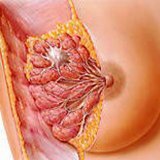Lactostasis: symptoms, treatment

With this problem, probably, faced every woman who has children, and, especially, those mothers who fed their babies with their breasts. So, His Majesty lactostasis: symptoms, treatment. In itself, this disease does not pose a threat to the continuation of the process of feeding, but it causes a lot of unpleasant problems to the woman. What is lactostasis, you ask? And nothing more than a banal stagnation of milk in several different areas of the breast, which is the cause of the drawing of pain and sometimes even a rise in temperature. The emergence of lactostasis must be taken seriously, in order to prevent new, more severe health problems.
Causes and symptoms of lactostasis.
Often, the causes of this disease are either increased milk production, or a violation of the outflow process due to blockage or narrow ducts in various areas of the breast. As for the factors that contribute to the onset of this disease, it is:
- a mismatch in the ratio of the active functioning of the glandular tissue, which is involved in the production of milk and the lumen diameter of the milky passage itself;
- is also very important factor may be a crack on the nipple or its flat shape, which in itself makes it difficult to pass the milk;
- in the transition from natural to artificial feeding;
- presence of all sorts of stresses or physical exertions that can lead to spasms in the milk ducts;
- special place is occupied by received bruises and traumas of a breast and a thorax;
- abnormal breastfeeding due to incorrect application of the baby, in which there is no complete emptying of the breast;
- squeezing the chest as when feeding, wearing tight underwear or while sleeping on the stomach;
- with sagging of the breast makes it difficult to completely drain the milk located in its lower part;
- processes in the presence of drafts or when undercooling, there is a "chilling" of the mammary gland.
Knowing and taking into account these factors, you can avoid the process of lactostasis. What you need to remember yet. Well, firstly, the fact that lactation is established on the third or fourth day after delivery, when there is an active production of milk. During this period, a newborn baby sucks out a very small amount of milk, which indicates an incomplete emptying of the breast. This phenomenon leads to an increase in pressure in the lumen of the dairy ducts and its lobules. Further, as the chain is a small edema and, of course, the infiltration of tissue of a certain area, which is the cause of pain, both internal and external nature. In addition, the whole process significantly influences the reduction of the lactation process, and threatens to completely lose it. At the same time, the milk left in the chest is subjected to a reverse absorption process, acquiring pyrogenic properties and provoking an increase in the temperature of the whole body by the so-called "milk fever".
Symptoms of lactostasis are as follows. This is, first of all, the presence of pain in the mammary glands, the formation of areas of compaction, sometimes all accompanied by an increase in temperature. It should be remembered that if the fight against this kind of symptoms within 2-3 days does not end with positive results, then lactostasis can smoothly flow into such a disease as mastitis and bring with it a lot of problems and complications. The distinctive qualities of mastitis is reddening of the skin in places of its compaction and the appearance of very severe pain during feeding, sometimes it can form a suppuration that will go directly to the milk, which is dangerous for both the lactating woman and her child. This situation requires an immediate request to doctors for help, and in some cases, hospital services, up to surgical intervention in the mammary gland.
Prevention and treatment of lactostasis.
With regard to preventive measures, this is, first, compliance with measures for the continuous monitoring of milk in the chest. To control the immense reception of liquid, this applies not only to drinking, but also to the first dishes and per day should not exceed one liter. It is not easy to take this step, as a lactating mother always has a thirst, but, nevertheless, this is a necessary step. Another effective method of prevention is to always put the baby to the breast. And you need to apply the baby at his first request and using two breasts alternately. If the milk in the breast has a prolonged stagnation, and the child is not able to dissolve it, then it is necessary to express a small amount of milk, which in turn will reduce the tension in the nasal region and facilitate the process of feeding.
Treatment of lactostasis involves massaging the mammary glands as needed, this helps improve blood circulation and prevent the formation of seals. Massage should be carried out only in circular motions starting from the periphery moving to the center of the gland.
If you notice that your child is not able to cope with a large amount of milk, and this contributes to the formation of seals, then most likely it will have to be decanted by means of special breast pumps or simply by hand, avoiding a strong pressure on the gland in order not to squeeze the ducts. Sometimes an experienced midwife is invited for these purposes, which will help and show you how to properly dissolve the mammary gland without causing the slightest harm. In some cases, warming compresses containing various oils or ointments such as camphor oil, Vaseline oil, Vishnevsky ointment or alcohol compresses( use only diluted alcohol to avoid burns) are very useful. To do this, moisten the gauze wipes in oil and alcohol in proportions of 1: 1 and apply to the mammary gland, then cover with a layer of cellophane and fix it all with a diaper or bandage, do not remove the compress for about six hours.
Symptoms and treatment, these are the two main whales on which a safe cure for this disease will be based.



